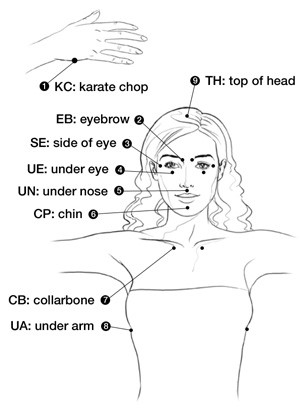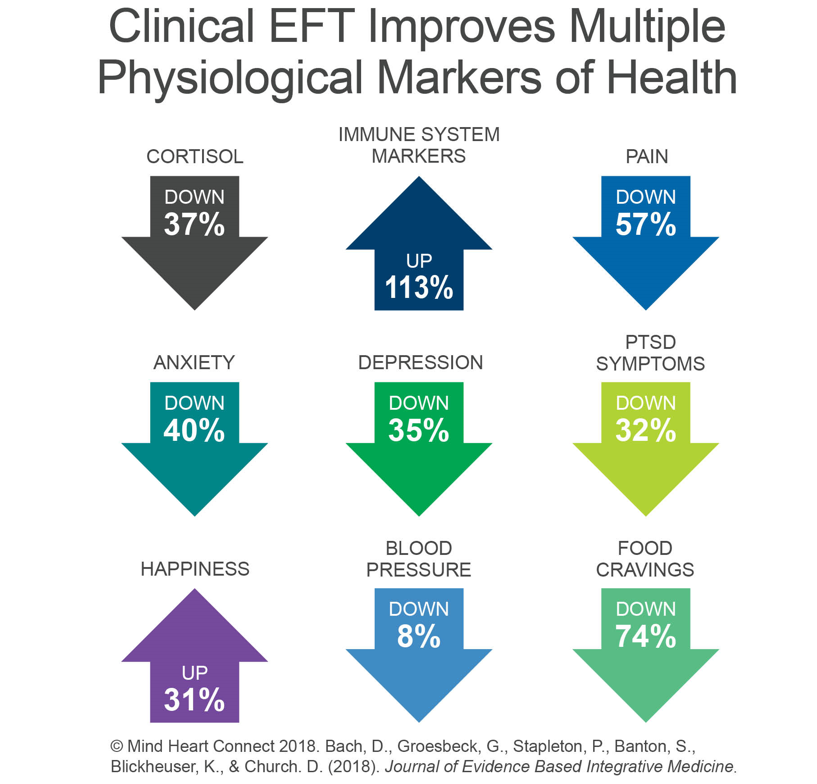EFT/TAPPING
Emotion Freedom Technique, also known as tapping, is a client directed therapy that brings together elements of psychotherapy; exposure, cognitive therapy and somatic stimulation and acupressure/energy therapy. EFT has been referred to as ‘psychological acupuncture’ without the needles. EFT stimulates various pressure points on the face and body to relieve stress, which then alleviates many psychological based concerns.

How Does it Work?
The cause of negative emotion is a disruption in the body’s energy system.
Stimulating acupressure points on the body with two-finger tapping results in a calming effect on the amygdala (the stress centre of the brain) and the hippocampus (the brains memory centre) of the brain.
High cortisol levels can be caused by a variety of things, including biological stressors, and mood disorders such as depression, anxiety and psychological stress.
When we are upset these feelings change our energy, and we feel sluggish and start to experience negative emotions, left long enough these may impact on our bodies and our minds. Our bodies start to reflect the way we feel.
EFT significantly increases positive emotions and self-esteem and resilience, and decreases negative emotional states.
This method is very effective and powerful.
It can clear things people have been holding onto by shifting their emotions, thereby freeing their minds and bodies.

What can EFT help with?
- Depression
- Anxieties
- Phobias
- Stress
- Traumas
- Low self esteem
- Guilt
- Sleep Problems
- Weight Loss
- Indecisiveness
- Anger
- Resentment
- Fears
- Allergies
- Food Cravings
- Physical Symptoms
- Harmful Beliefs
- Financial worries
1 hour @ A$120.00
Clinical Research:
Emotional Freedom Techniques Improves Multiple Physiological Markers of Health:
Abstract:
Emotional Freedom Technique (EFT) is an evidence-based self-help therapeutic method and over 100 studies demonstrate its efficacy. However, information about the physiological effects of EFT is limited. The current study sought to elucidate EFTs mechanisms of action across the central nervous system (CNS) by measuring heart rate variability (HRV) and heart coherence (HC); the circulatory system using resting heart rate (RHR) and blood pressure (BP); the endocrine system using cortisol, and the immune system using salivary immunoglobulin A (SigA). The second aim was to measure psychological symptoms. Participants (N = 203) were enrolled in a 4-day training workshop held in different locations. At one workshop (n = 31), participants also received comprehensive physiological testing. Posttest, significant declines were found in anxiety (−40%), depression (−35%), posttraumatic stress disorder (−32%), pain (−57%), and cravings (−74%), all P < .000. Happiness increased (+31%, P = .000) as did SigA (+113%, P = .017). Significant improvements were found in RHR (−8%, P = .001), cortisol (−37%, P < .000), systolic BP (−6%, P = .001), and diastolic BP (−8%, P < .000). Positive trends were observed for HRV and HC and gains were maintained on follow-up, indicating EFT results in positive health effects as well as increased mental well-being.
Bach D, Groesbeck G, Stapleton P, Sims R, Blickheuser K, Church D. Clinical EFT (Emotional Freedom Techniques) Improves Multiple Physiological Markers of Health. J Evid Based Integr Med. 2019;24:2515690X18823691. doi:10.1177/2515690X18823691
Clinical EFT as an Evidence-Based Practice for the Treatment of Psychological and Physiological Research Paper:
Abstract:
Emotional Freedom Techniques (EFT) has moved in the past two decades from a fringe therapy to widespread professional acceptance. This paper defines Clinical EFT, the method validated in many research studies, and shows it to be an “evidence-based” practice. It describes standards by which therapies may be evaluated, such as those of the American Psychological Association (APA) Division 12 Task Force, and reviews the studies showing that Clinical EFT meets these criteria. Several research domains are discussed, summarizing studies of: 1) psychological conditions such as anxiety, depression, phobias, and posttraumatic stress disorder (PTSD); 2) physiological problems such as pain and autoimmune conditions; 3) professional and sports performance; and 4) the physiological mechanisms of action of Clinical EFT. The paper lists the conclusions that may be drawn from this body of evidence, which includes 23 randomized controlled trials and 17 within-subjects studies. The three essential ingredients of Clinical EFT are described: exposure, cognitive shift, and acupressure. The latter is shown to be an essential ingredient in EFT’s efficacy, and not merely a placebo. New evidence from emerging fields such as epigenetics, neural plasticity, psychoneuroimmunology, and evolutionary biology confirms the central link between emotion and physiology, and points to somatic stimulation as the element common to emerging psychotherapeutic methods. The paper outlines the next steps in EFT research, such as smartphone-based data gathering, large-scale group therapy, and the use of biomarkers. It concludes that Clinical EFT is a stable and mature method with an extensive evidence base. These characteristics have led to growing acceptance in primary care settings as a safe, rapid, reliable, and effective treatment for both psychological and medical diagnoses.
Conditions Dawson Church National Institute for Integrative Healthcare, Fulton, USA Email: dawsonchurch@gmail.com Received May 24th, 2013; revised July 5th, 2013; accepted July 15th, 2013 Copyright © 2013 Dawson Church.
